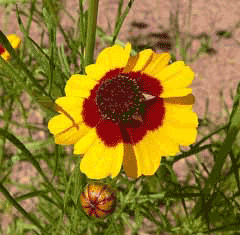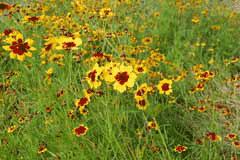 |
|
http://commons.wikimedia.org/wiki/User:Stan_Shebs |
 |
| http://commons.wikimedia.org/wiki/User:Rl |
Translate this page:
Summary
Bloom Color: Orange, Red, Yellow.
Main Bloom Time: Early summer, Early fall, Late summer, Late spring, Mid summer. Form: Upright or erect.
Physical Characteristics

 Coreopsis tinctoria is a ANNUAL growing to 0.8 m (2ft 7in) by 0.2 m (0ft 8in) at a medium rate.
Coreopsis tinctoria is a ANNUAL growing to 0.8 m (2ft 7in) by 0.2 m (0ft 8in) at a medium rate.
See above for USDA hardiness. It is hardy to UK zone 3. It is in leaf from April to November, in flower from June to September, and the seeds ripen from June to October. The species is hermaphrodite (has both male and female organs) and is pollinated by Bees.
It is noted for attracting wildlife.
Suitable for: light (sandy) and medium (loamy) soils and prefers well-drained soil. Suitable pH: mildly acid, neutral and basic (mildly alkaline) soils. It cannot grow in the shade. It prefers dry or moist soil and can tolerate drought.
UK Hardiness Map
US Hardiness Map
Synonyms
Plant Habitats
Cultivated Beds;
Edible Uses
Edible Parts:
Edible Uses: Coffee
A tea can be made from the dried plant[257]. It was used as a coffee substitute[257].
References More on Edible Uses
Medicinal Uses
Plants For A Future can not take any responsibility for any adverse effects from the use of plants. Always seek advice from a professional before using a plant medicinally.
Astringent Emetic
A tea made from the roots is emetic and is also used in the treatment of diarrhoea[222, 257]. An infusion of the whole plant without the root has been used by women desiring a female baby[257].
References More on Medicinal Uses
The Bookshop: Edible Plant Books
Our Latest books on Perennial Plants For Food Forests and Permaculture Gardens in paperback or digital formats.

Edible Tropical Plants
Food Forest Plants for Hotter Conditions: 250+ Plants For Tropical Food Forests & Permaculture Gardens.
More

Edible Temperate Plants
Plants for Your Food Forest: 500 Plants for Temperate Food Forests & Permaculture Gardens.
More

More Books
PFAF have eight books available in paperback and digital formats. Browse the shop for more information.
Shop Now
Other Uses
Dye
A yellow (red with an acid mordant) dye is obtained from the flowers and is used to dye cloth[169, 244, 257]. It is not very good when used on plant fibres[169]. The flowers can be dried for later use[169]. Cultivated as an ornamental plant for gardens, and as a native plant for wildlife gardens and natural landscaping.
Special Uses
Attracts Wildlife
References More on Other Uses
Cultivation details
Landscape Uses:Border, Container, Foundation, Massing, Specimen. Succeeds in ordinary garden soil[1]. Prefers a fertile well-drained moisture retentive medium soil[111, 200]. Does well in sandy soils[188]. Requires a sunny position[111, 200]. Established plants are drought resistant[1]. A good bee plant[200]. Special Features:
Attracts birds, North American native, Naturalizing, Wetlands plant, Attracts butterflies, Suitable for cut flowers.
References Carbon Farming Information and Carbon Sequestration Information
Temperature Converter
Type a value in the Celsius field to convert the value to Fahrenheit:
Fahrenheit:
The PFAF Bookshop
Plants For A Future have a number of books available in paperback and digital form. Book titles include Edible Plants, Edible Perennials, Edible Trees,Edible Shrubs, Woodland Gardening, and Temperate Food Forest Plants. Our new book is Food Forest Plants For Hotter Conditions (Tropical and Sub-Tropical).
Shop Now
Plant Propagation
Seed - sow March in a cold frame. When they are large enough to handle, prick the seedlings out into individual pots and plant them out in the summer[111]. If you have sufficient seed then it can also be sown in situ outdoors.
Other Names
If available other names are mentioned here
This taxon has not yet been assessed.
Native Range
NORTHERN AMERICA: Canada (Québec, Ontario, Saskatchewan (south), Alberta (south), Manitoba (south), British Columbia (south)), United States (Connecticut, Indiana, Maine, Massachusetts, Michigan, New Hampshire, New Jersey, New York, Ohio, Pennsylvania, Rhode Island, Vermont, West Virginia, Iowa, Kansas, Minnesota (south), Missouri, Nebraska, North Dakota, South Dakota, Illinois, Oklahoma, Wisconsin, Colorado (east), Idaho, Montana, Oregon, Washington, Wyoming (east), Alabama, Arkansas, Delaware, District of Columbia, Florida, Georgia, Kentucky, Louisiana, Maryland, Mississippi, North Carolina, South Carolina, Tennessee, Virginia, New Mexico, Texas, Arizona, California), Mexico (Coahuila de Zaragoza, Nuevo León (north), Tamaulipas (north))
Weed Potential
Right plant wrong place. We are currently updating this section.
Please note that a plant may be invasive in one area but may not in your area so it's worth checking.
This plant can be weedy or invasive
Conservation Status
IUCN Red List of Threatened Plants Status : This taxon has not yet been assessed

Growth: S = slow M = medium F = fast. Soil: L = light (sandy) M = medium H = heavy (clay). pH: A = acid N = neutral B = basic (alkaline). Shade: F = full shade S = semi-shade N = no shade. Moisture: D = dry M = Moist We = wet Wa = water.
Now available:
Food Forest Plants for Mediterranean Conditions
350+ Perennial Plants For Mediterranean and Drier Food Forests and Permaculture Gardens.
[Paperback and eBook]
This is the third in Plants For A Future's series of plant guides for food forests tailored to
specific climate zones. Following volumes on temperate and tropical ecosystems, this book focuses
on species suited to Mediterranean conditions—regions with hot, dry summers and cool, wet winters,
often facing the added challenge of climate change.
Read More
Expert comment
Author
Nutt.
Botanical References
60200
Links / References
For a list of references used on this page please go here
Readers comment
| Add a comment |
|
If you have important information about this plant that may help other users please add a comment or link below. Only comments or links that are felt to be directly relevant to a plant will be included. If you think a comment/link or information contained on this page is inaccurate or misleading we would welcome your feedback at [email protected]. If you have questions about a plant please use the Forum on this website as we do not have the resources to answer questions ourselves.
* Please note: the comments by website users are not necessarily those held by PFAF and may give misleading or inaccurate information.
To leave a comment please Register or login here All comments need to be approved so will not appear immediately.
|
Subject : Coreopsis tinctoria
|
|
|
|